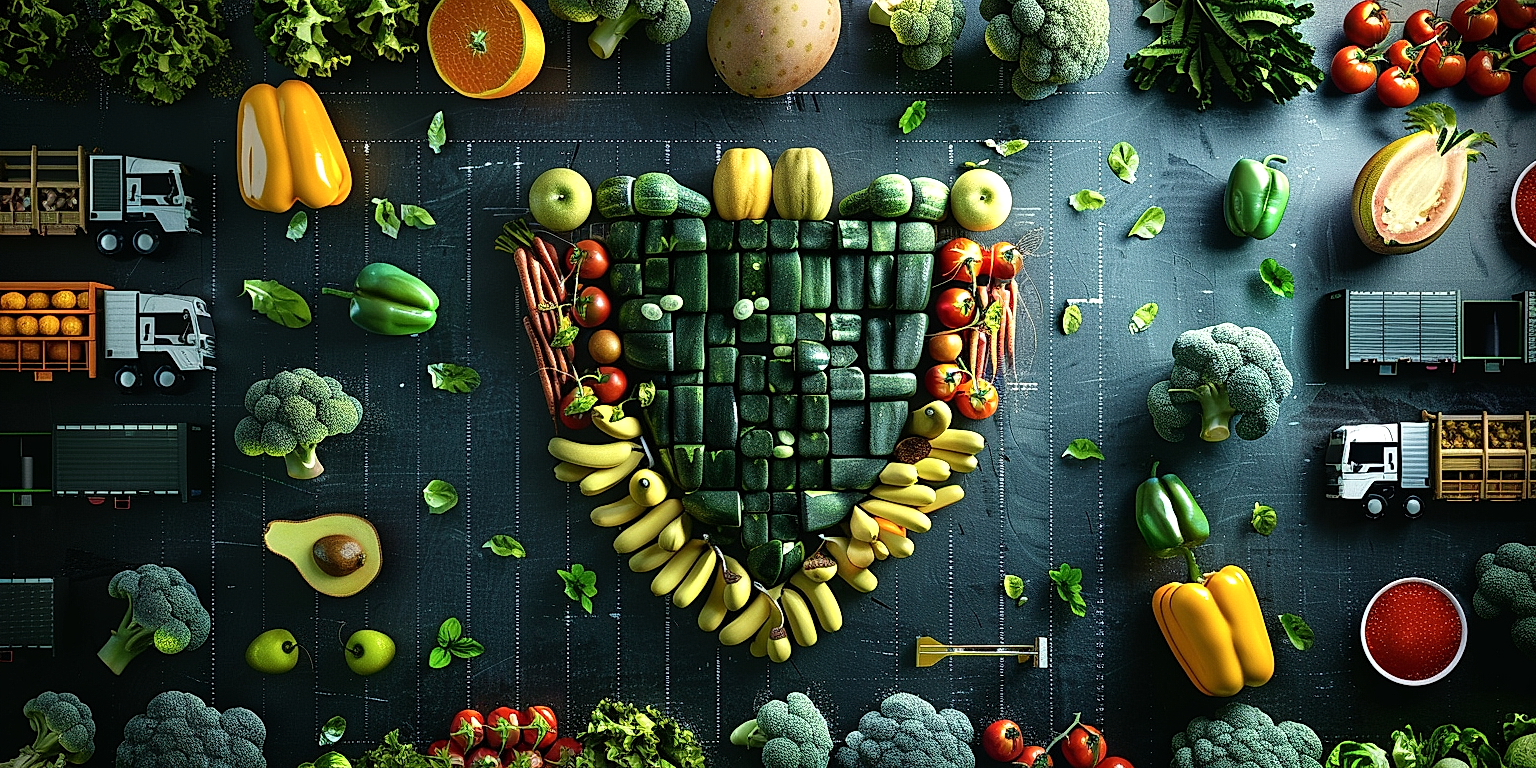The logistics of proper food distribution carry significant weight in maintaining overall food safety.
Sustainable agriculture depends not only on farming practices but also on efficient handling, storage, and distribution systems.
A tiny mistake in any of these steps may result in severe consequences, such as foodborne illnesses or waste.
Best practices and technological advancements are crucial in mitigating risks associated with foodborne outbreaks.
This article provides an encompassing overview of the latest enhancements that contribute to food safety in produce distribution.
Emphasis will be given to identifying new strategies, technologies, and methods that ensure we receive fresh, safe, and nutritious fruits and vegetables.
Contents
- Food Safety Enhancements In Produce Distribution
- 1. Improved temperature control during transport.
- 2. Enhanced Cleanliness in Handling and Packaging
- 3. Use of Food Safety Tracking Technology
- 4. Increased Frequency of Safety Inspections.
- 5. Implementation of Strict Quality Control in Food Safety Enhancements
- 6. Better Training for Handling and Distribution Staff
- 7. Advanced Microbial Testing and Contamination Detection
- The Bottom Line
Food Safety Enhancements In Produce Distribution
1. Improved temperature control during transport.
Maintaining appropriate temperature levels during transport is a vital aspect of ensuring food safety in produce distribution.
This is particularly indispensable for perishable goods such as fruits and vegetables.
Effective temperature control prevents bacterial growth which can cause foodborne illnesses.
It is imperative that all links in the distribution chain pay proper attention to temperature control in order to maintain the quality and safety of produce.
Advanced refrigeration systems in transportation vehicles play a significant role in temperature control.
These tailored systems provide consistent and accurate temperature management, ensuring the freshness of the produce from source to destination.
Furthermore, the use of temperature monitoring devices and digital technology has greatly enhanced the ability to modulate temperatures during transport.
These technologies not only monitor but alert carriers if temperature fluctuations that may hinder the safety of the produce occur.
Increasingly, insulated packaging materials are being used in produce distribution.
These materials not only maintain desired temperatures but also reduce chances of contamination.
Also, there is a need to maintain accurate documentation regarding temperature levels throughout the transport process.
Documentation provides essential back-stop information that can be useful in ensuring continued improvement in procedures.
Regulation bodies are also playing a critical part by enforcing stringent rules for temperature maintenance during transport.
These bodies perform checks at various points in the distribution chain to ensure standards are met.
Overall, improved temperature control during transport is a multi-faceted approach which requires cooperation between various stakeholders in the produce distribution chain.
With the incorporation of the latest technology, proper packing materials, and strict regulation, food safety during transport is being markedly enhanced.
2. Enhanced Cleanliness in Handling and Packaging
One of the crucial aspects of food safety in produce distribution relates to the enhancement of cleanliness during handling and packaging.
Produce, being a major component of the global food supply chain, is subject to extensive handling and packaging before distribution.
It goes without saying that the risk of contamination increases with every touchpoint, thereby making cleanliness during handling and packaging a major priority.
Effective cleanliness in the handling and packaging process ensures the safety of the produce, boosting consumer confidence and reducing the likelihood of food-borne diseases.
One way to ensure cleanliness in handling and packaging is to enforce strict hygiene practices among the staff.
This may include frequent hand washing, usage of gloves and masks, and disinfecting tools and surfaces regularly.
Adopting such practices is significant because pathogens can easily be transferred from the hands of workers to the produce during the handling and packaging process.
Negligence in maintaining cleanliness can lead to disastrous consequences, including widespread foodborne illnesses.
Another important step towards enhancing cleanliness involves the selection of appropriate packaging materials.
These materials should be not only be safe and free from toxins but also capable of preventing contamination during transportation.
It is also important to note that the cleanliness does not stop at the packaging stage; it must be maintained during the transportation and distribution stages as well.
Implementing cleanliness checks at every stage of the distribution will help to ensure that the produce is safe right from the farm to the table.
Incorporating effective sanitation and hygiene policies in handling and packaging not only improves food safety but also enhances the overall quality of the produce.
Such a comprehensive process for cleanliness helps in building trust among consumers regarding the safety and quality of the produce they purchase.
Enhancing cleanliness in handling and packaging is thus a crucial approach in ensuring food safety enhancements in produce distribution.
3. Use of Food Safety Tracking Technology
One innovative method of enhancing food safety in produce distribution is the use of food safety tracking technology.
This kind of technology provides enhanced traceability of food products from the farm to the consumer.
It has grown increasingly important due to the complexity and global scale of today’s food supply chains.
Food safety tracking technology not only ensures the quality and safety of produce but also helps in the swift identification and resolution of foodborne outbreak source.
By implementing such systems, companies can improve their understanding, management, and communication about risks associated with food safety.
These technologies include a mix of tools like barcode scanners, Radio Frequency Identification (RFID), and data management software, which all play crucial roles in the overall system.
The implementation and use of barcode scanners help in tracking produce at every stage of the supply chain.
RFID tags, on the other hand, store and wirelessly transmit data about an object’s identity, history, and location.
This allows for real-time updates on a product’s location and condition, thus ensuring optimal food safety.
Data management software gives companies the power to aggregate, analyze, and visualize data from multiple sources.
Such software applications can identify potential pattern, trends and areas of concern early in the distribution process, hence mitigating potential risks.
However, while food safety tracking technology offers numerous benefits, it also presents some challenges and hurdles for implementation.
One significant hurdle is the high initial cost of investing in sophisticated tracking technology.
Plus, companies must also grapple with the intricacies of integrating these technologies into their existing operations and systems.
But despite these challenges, the adoption of food safety tracking technology is a strategic necessity in today’s competitive food industry, particularly in produce distribution.
This underlines the importance of continued innovation and investment in food safety technology to ensure the integrity and safety of food supplies worldwide.
4. Increased Frequency of Safety Inspections.
The frequency of safety inspections is a critical aspect of food safety, especially in the distribution of produce.
It ensures the integrity of products from the point of harvest to the point of sale.
Regular inspections also guarantee that food-handling protocols and storage conditions are adhered to throughout the transit process.
By increasing the frequency of these inspections, businesses can identify potential issues more quickly and implement necessary corrective actions promptly.
This ultimately helps protect the end consumers from consuming spoiled or contaminated food.
An increased inspection frequency also serves as a deterrent against employees and handlers who may otherwise be tempted to overlook safety regulations.
People are more likely to follow rules and procedures when they know they are being watched and held accountable.
A number of factors should be considered when deciding on the inspection frequency, including the type of produce, the storage conditions, the distance and duration of transit, and the quality control records of the parties involved in the distribution chain.
To organize and conduct regular inspections effectively, businesses need to have a well-documented and strictly implemented inspection plan.
This plan should specify the scope of the inspection, the criteria to be evaluated, the frequency of the inspection, and the person responsible for carrying out the inspection.
Increased inspections may initially lead to increased costs for businesses in terms of time and resources.
However, in the long run, they help avoid costly recalls and damage to brand reputation that can result from safety issues.
In addition, they can also provide valuable data for ongoing optimization and continuous improvement of food safety in the distribution chain.
It is important to note that inspections alone are not sufficient to ensure food safety.
They must be incorporated into a comprehensive approach that includes other elements such as temperature control, cleanliness, quality control, and staff training.
Overall, the frequent safety inspections play a crucial role in enhancing food safety in the distribution of produce.
5. Implementation of Strict Quality Control in Food Safety Enhancements
Ensuring food safety in produce distribution necessitates the implementation of a stringent quality control system.
This system can be seen as one of the critical strategies for enhancing food safety.
Indispensably, it requires a meticulous approach to monitoring, detecting, and eliminating potential hazards that can compromise the quality and safety of products.
Quality control measures are essential in delivering fresh, nutritious, and safe produce to consumers.
As part of these quality control strategies, businesses must consider pre-harvest and post-harvest processes.
In pre-harvest processes, the emphasis is on the cultivation, water usage, and pest control practices to ensure the initial product quality.
Post-harvest processes, on the other hand, focus on the handling, packaging, storage, and transportation methods applied to maintain and enhance food safety.
Effective quality control measures demand a comprehensive understanding of the whole supply chain journey of produce—from farm-to-fork.
Quality control needs to adopt scientific and technologically advanced methods for precise and accurate safety verification.
Critical control points need identification and continuous monitoring to ensure complete food safety.
Among those points include temperatures, humidity, lighting, and cleanliness.
Quality control further requires the development and enforcement of strict safety standards and protocols.
It provides a framework for business operations and sets expectations towards maintaining high-quality produce throughout distribution.
However, for quality control to be truly effective, it needs regular review and continuous improvement to keep pace with emerging food safety challenges.
A significant aspect of quality control is transparent reporting and documentation.
For absolute transparency, the entire process of implementation needs to be documented correctly and shared with every stakeholder in the produce supply chain.
This documentation aids in identifying improvement areas and helps to maintain a consistent level of safety in produce distribution.
6. Better Training for Handling and Distribution Staff
One vital measure to enhance food safety in produce distribution is improving the training of the handling and distribution staff.
This approach is critical because the staff directly interacts with the food throughout the distribution process.
More in-depth, regular training can equip them with the necessary knowledge and skills to handle the produce safely and efficiently.
In the training sessions, staff should be educated on the importance of proper food handling to maintain food safety standards.
They must also understand the potential consequences of mishandling produce, which can lead to widespread outbreaks of foodborne illnesses.
Furthermore, staff training should include specific protocols on how to handle food in different situations, such as during various weather conditions, transportation issues, or outbreaks of diseases on the farm.
Farm produce can be particularly susceptible to contamination during the transport stage, and thus it is critical that staff understands how to pack, store, and transport items properly.
Training should also educate staff about the importance of personal hygiene and cleanliness, as this can directly affect the safety of the produce.
Information about how to properly clean equipment and facilities used in the distribution process should also be included in staff training materials.
Besides, regularly updated refresher courses should be held to ensure that the staff is informed of the latest food safety regulations and practices.
Effective training also necessitates assessing the staff’s understanding and implementation of the lessons learned.
Therefore, regular checks and evaluations should be promoted to examine whether staff members are following food safety protocols correctly.
If gaps are found in the staff’s knowledge or practice, targeted training modules should be developed to specifically address these areas.
Moreover, offering recognition or rewards for staff who demonstrate exceptional commitment to food safety can encourage everyone to take safety protocols seriously.
By investing in comprehensive and regular staff training, produce distribution companies can significantly improve their food safety, thus contributing to the health and well-being of consumers across the globe.
Substantial staff training is, therefore, a necessary investment for every company aiming to enhance food safety in produce distribution.
7. Advanced Microbial Testing and Contamination Detection
The introduction of advanced microbial testing in the food distribution chain has been a significant milestone.
This form of testing allows distributors to identify and eliminate harmful microbial contamination in food products before they reach consumers.
The advanced tests are incredibly sensitive, capable of detecting the presence of harmful microorganisms at the slightest trace levels.
These tests have helped in the reduction of foodborne illnesses, as they ensure food safety effectively.
Traditionally, microbial testing was a long and tedious process which sometimes took several days to produce results.
However, with advancements in technology, this timeframe has significantly reduced, paving the way for faster detection and control of microbial contamination.
Advanced microbial testing and contamination detection are crucial elements of the food distribution process that significantly enhance food safety.
Advanced microbial tests do not just detect the presence of harmful organisms; they can determine the precise strains of these organisms.
This level of specificity allows distributors to implement targeted remediation strategies to prevent further spread.
Microbial testing has also evolved to incorporate DNA sequencing technologies, which improve the level of detection and specificity.
The introduction of these technologies has revolutionized food safety in the produce distribution industry.
Digital software tools are now available for use in tracking and reporting contamination detection.
These tools provide the ability for real-time updates and alerts for potential microbial risks.
Microbial testing kits and handheld devices have also been developed for on-site and rapid testing.
Food distributors can therefore perform tests at different levels of distribution, from fields and packing houses to transportation and retail points.
The evolution of microbial testing technology has seen the inclusion of predictive analytics, allowing for future contaminant estimations and risks.
This predictive aspect helps distributors to take proactive measures, thus ensuring enhanced food safety.
The Bottom Line
Improving the safety of our food supply chain is a multifaceted effort, requiring the collaboration of multiple stakeholders from transporters to handling and packaging personnel.
Shared responsibility exists to ensure both temperature control and cleanliness, protecting the food’s integrity and consumer health.
Advancements in tracking technology complement routine safety inspections and strict quality control systems, enabling swift prevention and control of threats.
Critical too is the upskilling of our staff, nurturing an agile team capable of responding deftly to safety challenges.
The added shield of modern microbial testing and contamination detection techniques further fortifies this system.
Therefore, the steady march of technological progress, combined with human vigilance, is showcasing a promising path forward in ensuring food safety from the farm to our tables.




